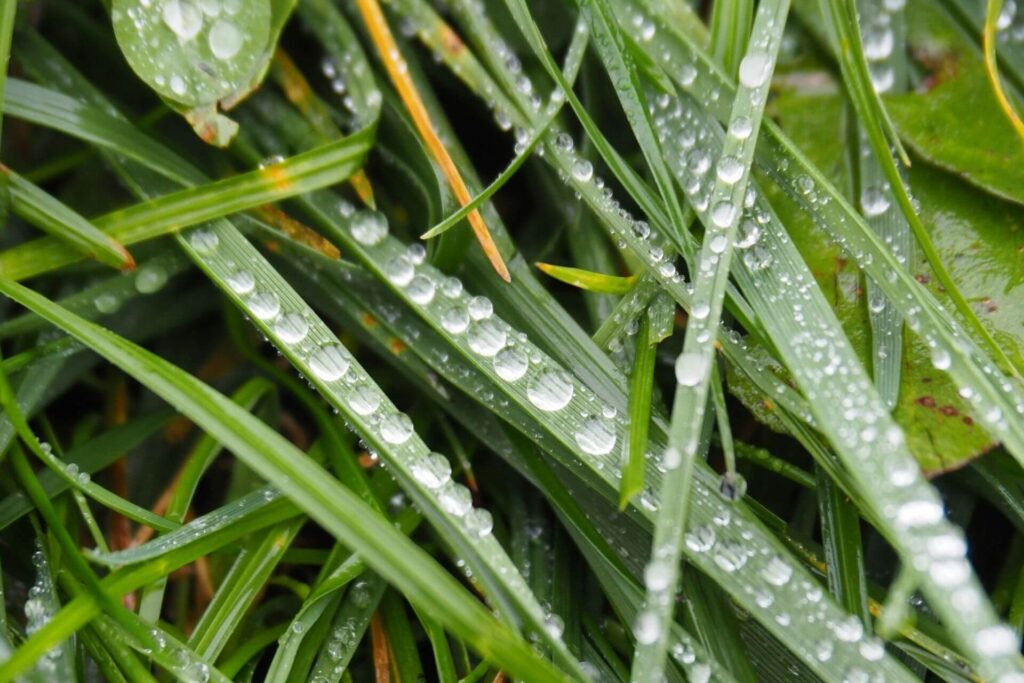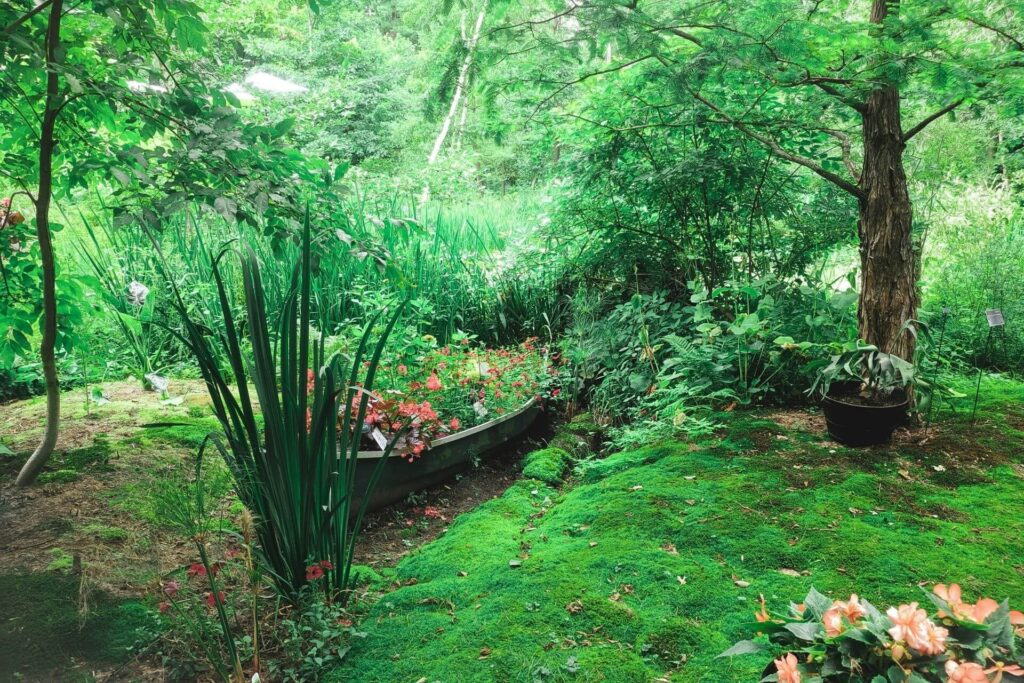Rain garden design has taken off as a foundation of sustainable landscaping. These unique property features allow people to ease runoff pollution and help recover ecosystems using striking vegetation and natural elements.
To ensure rain garden installation is implemented correctly, expert landscapers must integrate key design principles into each project. A sharp sense of the advantages, functions and care requirements will help them educate clients and zero in on their approach to sustainable gardening.
An Overview of Rain Garden Design

Standing water may compact soil and reduce oxygen absorption, causing grass to wilt, turn yellow or die off over time. Excess water is also conducive to muddy areas and fungal and moss growth, further hindering a lawn’s appearance.
To prevent unsightliness, a rain garden relies on moisture-tolerant plants, quality dirt, and biological processes to absorb and purify stormwater runoff from walkways, driveways, rooftops and compacted ground. Most importantly, these yard features stop contaminants from entering fragile waterways and ecosystems.
Although there are a few similarities, there is at least one significant difference between a rain garden versus a bioswale. Rainwater garden designs are much shallower, plant-filled catchments, while bioswales are deeper, elongated channels that treat large quantities of runoff water.
Because they are smaller, rain gardens are preferred for tight spaces, including waterlogged residential lots and urban settings. Likewise, they provide more aesthetic possibilities, from versatile, colorful plants to visually stunning layouts and themes.
The Benefits of Rain Gardens
Knowledgeable landscapers should be able to relay the benefits of rain gardens to clients. In addition to collecting and filtering fertilizer residues, salts, metals and oils from porous surfaces, they also aid in the following:
- Prevent algal blooms and protect aquatic species in nearby water bodies
- Reduce lawn damage, puddling and foul odors in flooded yards
- Decrease pest infestations and mosquito breeding grounds by lessening standing water
- Create a habitat for local wildlife and attract pollinators like butterflies and birds
- Secure soil and reduce erosion, especially using native plants
One study even found rain gardens can filter pollutants from salted roads during the winter. Salt used to deice roadways during cold-weather events increases heavy metal loads in stormwater runoff. The findings were important because they demonstrated the effectiveness of year-round rainwater garden designs in managing the impacts.
How to Create a Rain Garden: 5 Essential Design Principles

Landscapers must follow key design principles when planting a rain garden on a property. This means they must consider location, plant selection, soil quality and water flow, among other factors, for the most successful results.
1. Location
Rain garden installation requires careful planning. How big is the roof or surface area you plan to drain? How well does the soil drain on the property? What depth should the rain garden be?
You’ll want to place it at least 10 feet away from a house so the water can adequately empty from downspouts and hard surfaces. Do not install it over septic tanks.
You should also avoid growing a rain garden where there is constant ground saturation. The catchment should be able to drain completely within 24 hours.
2. Soil Quality
When planting a rain garden, always start with well-draining dirt, especially for plants to thrive and function efficiently. This may require digging deeper and adding organic matter like mulch, rocks, sand and compost to prevent compaction and boost nutrients and microbial activity.
Soil compaction — caused by foot traffic or natural density — makes it harder for rain gardens to carry out their purpose. As such, testing the soil beforehand may be necessary to determine its exact composition.
3. Plant Selection
Vegetation dramatically impacts how well rain gardens soak and filter stormwater runoff, but they must be able to tolerate both wet and dry conditions. Native plants are already adapted to the local climate and are a great starting point. Other plant types to consider include:
- Trees and shrubbery: Slows rainfall, allowing for better absorption
- Tall grasses: Excellent at filtering water and trapping contaminants
- Deep-rooted plants: Holds soil in place and encourages continuous water flow
Ornamental grasses are among the best vegetation options due to their ability to withstand submergence and fluctuating water tables, making them ideal for landscape projects.
For example, one study found that Northwind switch grass and Chinese silver grass could tolerate 30 centimeters of water for seven-day periods. Meanwhile, little bluestem grass, feather reed grass and blue grama grass were most flood- and drought-resistant when soil moisture levels remained around 14%.
Other options include milkweed, coneflowers, butterfly weed, bee balm, canna lily and black-eyed Susans, depending on the agricultural zone.
4. Structural Design
The actual rainwater garden design determines its performance and resilience. Landscapers must devise the perfect shape, slope, inlet and outlet for optimal flow, absorption and filtration.
For example, the inlet must enable water flow into the catchment while the outlet effectively addresses overflow during heavy precipitation. A gentle easement with varying curvatures will also help manage discharge and drainage.
From an aesthetic perspective, the rain garden’s shape can become part of the overall landscape design, serving as an attractive focal point and enhancing curb appeal.
5. Maintenance
Although rain garden maintenance isn’t as extensive as other landscaping needs, it does need occasional care to remain productive. For example, landscape professionals must regularly check for erosion and sedimentation and dredge accordingly to promote plant development and streaming. Suction dredgers are best for silt or other soft materials, while cutter suction dredgers are suitable for compacted sand and clay buildup.
Otherwise, landscapers should water and weed a newly planted rain garden weekly for optimal growth. As time goes on, you can prune and mulch annually. Also, you should remove dead flora so it continues absorbing and filtering runoff properly.
Creative Rain Garden Concepts for Every Landscape

Clients may have difficulty deciding on the best landscaping projects for their property. Therefore, whatever rain garden ideas you have will help them make the most practical and attractive decisions to enhance their curb appeal. Some creative concepts to suggest include the following:
- Sculptural channels: Artistic channel shapes for improved water flow and decorative appeal
- Rooftop rain garden: Ideal for urban settings in which rooftop vegetation captures rainwater for various uses
- Habitat rain garden: Doubles as a water catchment and revitalized ecosystem for small critters, pollinators and beneficial insects
- Vertical rain gardens: Utilizes vertical elements and structures to maximize space and create a beautiful, vegetative spillover effect
- Themed rain gardens: Includes elements like gravel stepping stones for zen-inspired or fairy-like gardens for an interesting landscape feature
- Edible rain garden: Comprises fruit trees, vegetable crops and herb plantings for a sustainable and functional space.
If you decide to include edimentals in a rain garden, be sure the edible parts are aboveground and only plant them where runoff derives from a clean water source. Otherwise, food crops can uptake harmful chemicals, metals and waste.
Elevating Landscaping With Functional Rain Gardens
A rain garden is an ideal outdoor project for people looking to improve a waterlogged yard sustainably. By creating the perfect rainwater garden design using the most effective soil, plants and layouts, you can help clients achieve their landscape goals.

Leave a Reply